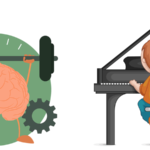People appear to have natural musicality. That is, the ability to comprehend and get joy from complex melodic examples seems, by all accounts, to be socially universal. Musicality is communicated ahead of schedule in development. In this sense, music might be contrasted with discourse—the other psychologically intriguing way that we utilize sound. Be that as it may, while discourse is most clearly significant for imparting recommendations or ideas, getting such information, this isn’t the essential capacity of music. Or maybe, it is music’s capacity to convey feelings, dispositions, or emotional mental states that appears to be valuable to our personal Telecharger Musique Libre De Droit.
Which carries us to the inquiry that shapes the title of this article: for what reason do we love music? All over, there is no obvious motivation behind why a grouping or example of sounds that has no particular propositional significance ought to evoke any sort of pleasurable reaction. However, music is broadly considered among our most noteworthy joys.
Where does this marvel originate from?
There are a few ways to deal with this inquiry. A musicologist may have a totally different answer than a social researcher. Since I’m a neuroscientist, I might want to address it from that point of view—perceiving that different viewpoints may likewise offer significant experiences. A preferred position of neuroscience is that we can relate our response to set up exact discoveries and draw from two particularly significant spaces: the neuroscience of hear-able observation and of the prize framework. To part with the climax of my article, I accept that music gets its capacity from an association between these two frameworks, the first permits us to dissect sound examples and make forecasts about them, and the second assesses the results of these forecasts and creates positive (or negative) feelings relying upon whether the desire was met, not met, or Christmas Royalty Free Music.
It’s amazing to imagine that all stable—a child crying, thunder, the strains of a three-step dance—is conveyed by simply vibrations of particles noticeable all around. Our rich phenomenological experience of these sounds is the result of a complex perceptual framework that takes these vibrations and changes them into what therapists call inner portrayals (recognition, contemplations, recollections, feelings, and so forth), which can be identified with our recollections of different sounds and information on the world all in all. Part of the cycle has to do with extricating pertinent acoustical highlights from the sounds and encoding them in the example of nerve firings.
This cycle is refined by activities occurring in three separate mind regions: the brainstem, thalamus, and hear-able cortex. A cello string when culled, for instance, will vibrate at a trademark recurrence dependent on the material science of its materials and its pressure; in the event that it is the primary line of an expectedly tuned cello, for instance, the whole length of the string would vibrate around multiple times in a single second.
A lot of exploration recommends that neurons in the hear-able cortex, particularly in the privilege cerebral half of the globe, are significant for recognizing fine degrees of recurrence, making the mental vibe Pitch is principal to most music, however it isn’t adequate simply to distinguish that a pitch has transformed; it is fundamental to decide the connections between pitches inside a melodic framework.
An initial class in music hypothesis would, as needs be, incorporate a portrayal of melodic stretches, the proportion between the frequencies of two tones, which decide the examples that structure tunes (when the tones are successive) and harmonies (when the tones are concurrent). Significantly, spans are characterized by the relations between pitches freely of the pitch esteems themselves. That is, a minor third is characterized (generally) as the proportion six to five, so any frequencies in that connection will be seen as a minor third.
This property, known as rendering, is the thing that permits us to perceive similar melody when sung in various keys (in the event that we didn’t have this limit, fronts of recognizable tunes would not work). A few investigations have demonstrated that the mind pathways for this sort of calculation lie outside the hear-able cortex appropriate, in districts associated with it that are additionally engaged with different sorts of tactile transformations.
A further inconvenience is that sounds vanish immediately from the climate—in contrast to, state, objects in a visual scene. Since sounds are fleeting, the cerebrum likewise needs a system to hold them incidentally as a main priority, so as to ascertain pitch connections, and different properties. (This is similarly significant for discourse, where a sentence couldn’t in any case be perceived since each word vanishes the moment it is spoken.) This limit relies upon the personnel called working memory: generally, the capacity to hold and deal with data over brief timeframe periods.
A few mind circuits radiating from the hear-able cortex, essentially the dorsolateral frontal cortex and back territories in the parietal projection, are significant for this capacity, and thus key for melodic perception. People with innate amusia (in some cases called musical inability)— the powerlessness to appreciate melodic connections and subsequently to see songs or other melodic structures—have been found to have decreased associations between hear-able regions and frontal locales, and hence battle to sort out the connections between sounds.



